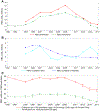Slowing decline in blood collection and transfusion in the United States - 2017
- PMID: 32086817
- PMCID: PMC7201859
- DOI: 10.1111/trf.15604
Slowing decline in blood collection and transfusion in the United States - 2017
Abstract
Introduction: The National Blood Collection and Utilization Survey (NBCUS) has demonstrated declines in blood collection and transfusion in the United States since 2008, including declines of 11.6% in red blood cell (RBC) collections and 13.9% in RBC transfusions during 2013-2015. This study described the 2017 NBCUS results.
Methods: The 2017 NBCUS was distributed to all US blood collection centers, all hospitals performing at least 1000 surgeries annually, and a 40% random sample of hospitals performing 100 to 999 surgeries annually. Weighting and imputation were used to generate national estimates for units of blood and components collected, deferred, distributed, transfused, and outdated.
Results: Response rates for the 2017 NBCUS were 88% for blood collection centers and 86% for transfusing hospitals. Compared with 2015, the number of RBC units collected during 2017 (12,211,000; 95% confidence interval [CI], 11,680,000-12,742,000) declined by 3.0%, and transfused RBC units (10,654,000, 95% CI, 10,314,000-10,995,000) declined by 6.1%. Distributed platelet (PLT) units (2,560,000; 95% CI, 2,391,000-2,730,000 units) increased by 5.1%, and transfused PLT units (1,937,000, 95% CI, 1,794,000-2,079,000) declined by 2.3%. Distributed plasma units (3,209,000; 95% CI, 2,879,000-3,539,000) declined by 13.6%, and transfused plasma units (2,374,000; 95% CI, 2,262,000-2,487,000) declined by 12.9%.
Conclusion: The 2017 NBCUS suggests a continued but slowing decline in demand for RBCs. The decline in blood collection and use will likely continue. Despite decreasing demand and increasing manufacturing costs of blood products, the US blood industry has met the regular and emergent needs of the country.
Published 2019. This article is a U.S. Government work and is in the public domain in the USA.
Conflict of interest statement
CONFLICT OF INTEREST
The authors have disclosed no conflicts of interest.
Figures


References
-
- Pfuntner A, Wier LM, Stocks C. Most frequent procedures performed in U.S. hospitals, 2010. HCUP statistical brief #149 Rockville (MD): Agency for Healthcare Research and Quality; 2013. - PubMed
-
- US Department of Health and Human Services. The 2011 national blood collection and utilization survey report. Washington, DC: US Department of Health and Human Services; 2013.
MeSH terms
Grants and funding
LinkOut - more resources
Full Text Sources
Medical
Miscellaneous

